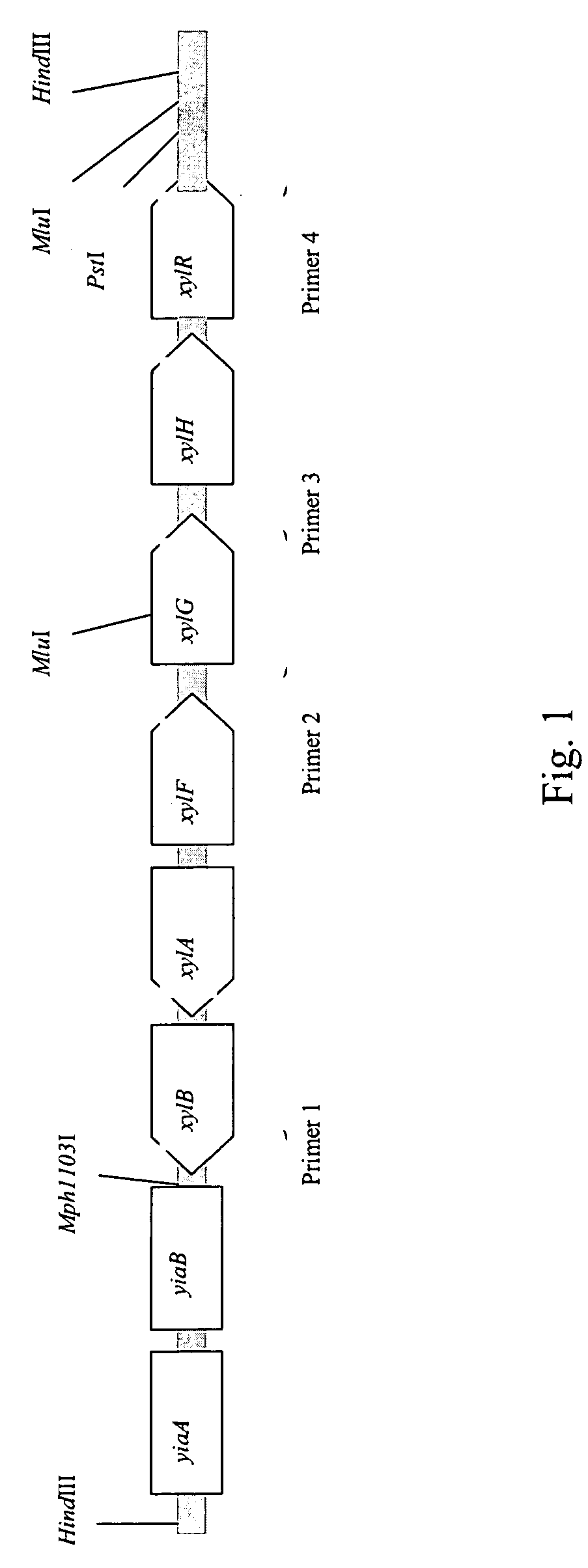Method for producing l-amino acids by fermentation using bacteria having enhanced expression of xylose utilization genes
a technology of utilization genes and xylose, which is applied in the field of l-amino acids produced by pentose fermentation, can solve the problems of not reporting the expression of xylose utilization genes by bacteria, the cost of molasses, corn, starch, etc., and the current use of molasses in the industry is rather high, so as to increase the expression amount of xylabfghr, enhance the activity of xylose utilization enzymes
- Summary
- Abstract
- Description
- Claims
- Application Information
AI Technical Summary
Benefits of technology
Problems solved by technology
Method used
Image
Examples
example 1
Cloning the xylABFGHR Locus from the Chromosome of E. coli Strain MG1655
[0127]Based on genome analysis of E. coli strain MG1655, the genes xylABFGHR can be cloned as a single HindIII fragment (13.1 kb) of 556 HindIII chromosomal fragments in total (FIG. 1). For that purpose, a gene library was constructed using vector pUC19, which is capable of surviving in E. coli with insertions of that size.
[0128]To construct such a library, chromosomal DNA of MG1655 was digested with HindIII restrictases and the pUC19 vector was digested with XbaI restrictase. The strain MG1655 (ATCC47076, ATCC700926) can be obtained from American Type Culture Collection (10801 University Boulevard, Manassas, Va., 20110-2209, U.S.A.).
[0129]Sticky ends in both DNA preparations were subsequently filled by Kienow fragment so as to prevent self-ligation (two bases filling). After the ligation procedure a pool of recombinant pUC19 plasmids was obtained. The size of the library is more then 200 thousand clones. The ge...
example 2
Production of L-Histidine by L-Histidine Producing Bacterium from Fermentation of a Mixture of Glucose and Pentoses
[0133]L-histidine producing E. Coli strain 80 was used as a strain for production of L-histidine by fermentation of a mixture of glucose and pentoses. E. Coli strain 80 (VKPM B-7270) is described in detail in Russian patent RU2119536 and has been deposited in the Russian National Collection of Industrial Microorganisms (Russia, 113545 Moscow, 1st Dorozhny proezd, 1) on Oct. 15, 1999 under accession number VRPM B-7270. Then, it was transferred to an international deposit under the provisions of the Budapest Treaty on Jul. 12, 2004. Transformation of strain 80 with the pMW119mod-xylA-R plasmid was performed by ordinary methods, yielding strain 80 / pMW119mod-xylA-R.
[0134]To obtain the seed culture, both strains 80 and 80 / pMW119mod-xylA-R were grown on a rotary shaker (250 rpm) at 27° C. for 6 hours in 40 ml test tubes (Ø18 mm) containing 2 ml of L-broth with 1 g / l of strept...
example 3
Production of L-Threonine by Fermentation of a Mixture of Glucose and Pentoses Using L-Threonine Producing Bacterium
[0138]L-threonine producing E. coli strain B-3996 was used to evaluate production of L-threonine by fermentation of a mixture of glucose and pentose. Transformation of strain B-3996 with the pMW119mod-xylA-R plasmid and vector pMW119 was performed by an ordinary method using CaCl2, yielding strains 3996 / pMW119mod-xylA-R and 3996 / pMW119, respectively.
[0139]Both E. coli strains B-3996 / pMW119 and B-3996 / pMW119mod-xylA-R were grown for 12-15 hours at 37° C. on L-agar plates containing streptomycin (50 mg / l) and ampicillin (150 mg / l). Then, the fermentation medium containing the carbon source xylose (4%) was inoculated with one loop of the strains. The fermentation was performed in 2 ml of fermentatin medium containing streptomycin (50 mg / l) in 20×200 mm test tubes. Cells were grown for 25 hours at 32° C. with shaking at 250 rpm.
[0140]After cultivation, the amount of L-thre...
PUM
| Property | Measurement | Unit |
|---|---|---|
| temperature | aaaaa | aaaaa |
| temperature | aaaaa | aaaaa |
| acid | aaaaa | aaaaa |
Abstract
Description
Claims
Application Information
 Login to View More
Login to View More - R&D
- Intellectual Property
- Life Sciences
- Materials
- Tech Scout
- Unparalleled Data Quality
- Higher Quality Content
- 60% Fewer Hallucinations
Browse by: Latest US Patents, China's latest patents, Technical Efficacy Thesaurus, Application Domain, Technology Topic, Popular Technical Reports.
© 2025 PatSnap. All rights reserved.Legal|Privacy policy|Modern Slavery Act Transparency Statement|Sitemap|About US| Contact US: help@patsnap.com


